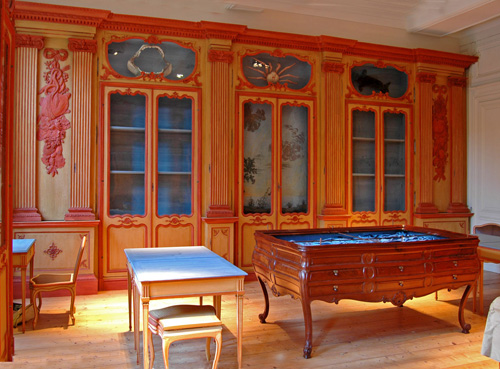
Le Cabinet de Clément Lafaille. Campagne de restauration 2006-2007. Atelier Dominique Chaussat.
21/01/2023Savant naturaliste du siècle des Lumières. Dossier enseignant . Muséum La Rochelle.
Extrait « Les mutations du cabinet du décès de Lafaille jusqu’à nos jours.
A l’occasion de la rénovation du début du XXIe siècle, Dominique Chaussat a pu reconstituer certaines modifications effectuées au fil du temps. Très peu usés, les pieds des tables et des chaises attestent qu’ils ont servi à bien peu de visiteurs. Un premier démontage et déménagement a eu lieu lors du décès de Lafaille pour transporter les meubles dans une maison sise à côté de l’Hotel de ville. C’est à cette occasion qu’on réduisit les boiseries dans toutes les dimensions et en particulier en hauteur.En 1794, Lavillemarais, chargé de s’occuper des collections d’Histoire naturelle de l’ancienne Académie constata la présence de 2 128 coquilles, loin des 4 000 évoquées par d’Argenville dans son inventaire du cabinet de Lafaille. Il inventorie également une multitude d’objets faisant partie du cabinet. Lavillemarais était déjà secrétaire perpétuel de l’Académie en 1783, à l’époque où le cabinet fut transféré près de la mairie et était donc bien placé pour observer les avaries de l’ensemble.On pratiqua un nouveau déménagement pour l’installation du mobilier dans le muséum ouvert en 1832. De nouvelles transformations eurent lieu pour ajuster les meubles à leur nouvelle salle, celle qu’ils occupent toujours actuellement. C’est à cette occasion notamment qu’on scinda une des armoires en deux.Au cours du XIXe siècle, les meubles furent utilisés sans qu’on leur accorde une valeur particulière. Ils furent séparés, dispersés à travers le muséum et peints . Ce fut en 1956 que le mobilier fut classé monument historique, à l’instigation d’un nouveau conservateur. En 1958 il fut décapé et repeint suivant les couleurs d’origine, et restauré par un ébéniste parisien. Le tout fut présenté dans l’esprit d’un cabinet de curiosité, sans s’attarder à l’exactitude des contenus ou de leur disposition.
II.D Les autres pièces de mobilier aujourd’hui adjointes
/Le cabinet Lafaille accueille aujourd’hui trois pièces de mobilier qui n’y auraient pas dépareillé.Le médaillier reste lié à la personne de Lafaille. Nous savons que celui-ci collectionna aussi des médailles. Il fit don du meuble à l’Académie en 1774. Le corps du meuble comporte des tiroirs aménagés pour recevoir des médailles. Le piétement actuel remplace un piétement datant de 1900 environXXXV.Médailler du cabinet Lafaille © MHNLREnsuite un globe terrestre fait écho au caractère ultramarin de nombreuses pièces de Lafaille. Il est posé sur un support en bois à quatre pieds. Le globe lui-même est composé de deux hémisphères en papier mâché rassemblées par un axe en bois. La sphère ainsi obtenue est ensuite recouverte de plâtre que l’on lisse à l’aide d’un gabarit. Ensuite on colle sur le globe les fuseaux gravés sur un papier. Akerman, graveur suédois spécialisé dans la réalisation de globes, est l’auteur de ce papier gravé. Mais la gravure a été complétée en 1780 par Frederic Akrel, un élève d’Akerman, et publiée à Uppsala. Il y a porté les dernières avancées de la science : les lignes d’égale déclinaison déterminées par Cook pour le pôle Sud. Ces lignes représentent un tracé fictif permettant aux navigateurs (…)
Vue du cabinet Lafaille en 1928 © MHNLR
(…) Ce fut en 1956 que le mobilier fut classé monument historique, à l’instigation d’un nouveau conservateur. En 1958 il fut décapé et repeint suivant les couleurs d’origine, et restauré par un ébéniste parisien. Le tout fut présenté dans l’esprit d’un cabinet de curiosité, sans s’attarder à l’exactitude des contenus ou de leur disposition.
Vue du cabinet Lafaille dans les années 1990 © MHNLR
décalage existant entre le pôle géographique et le pôle magnétique. Le tracé ondoyant visible sur le globe n’a plus de valeur scientifique mais atteste que l’objet fut un jour à la pointe du savoir… Il fut donné à l’Académie royale des Belles-Lettres, Sciences et Arts de La Rochelle par MM Debaussay et Nérac. Il n’était donc pas dans le cabinet de Lafaille.
Le coquillier est un meuble d’apparat en acajou de Cuba. Il fait partie de ce que l’on appelle les « meubles de port ». Dominique Chaussat considère comme très probable qu’il ait été réalisé par un artisan rochelais. Un meuble très semblable est visible sur un tableau d’ Alexandre Roslin (1718-1793) intitulé Portrait de Perronnet et de sa femme peint en 1759. Il est sculpté de coquilles sur les côtés en référence à son usage. Il n’en est fait nulle mention dans les documents du XVIIIe siècle que nous avons sur le cabinet. Ce n’est qu’à partir de 1885 que Paul Cassagneaud, alors conservateur du muséum et qui y est employé depuis 1830, parle du « meuble remarquable de style Louis XV, du même (Lafaille) donateur » dans une notice. En outre, le meuble paraît redondant par rapport aux douze tables- vitrines installées par Lafaille. (…)
